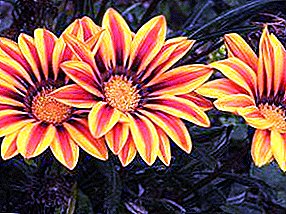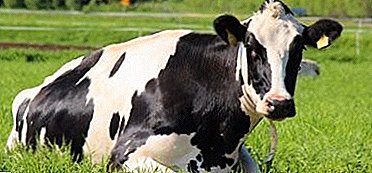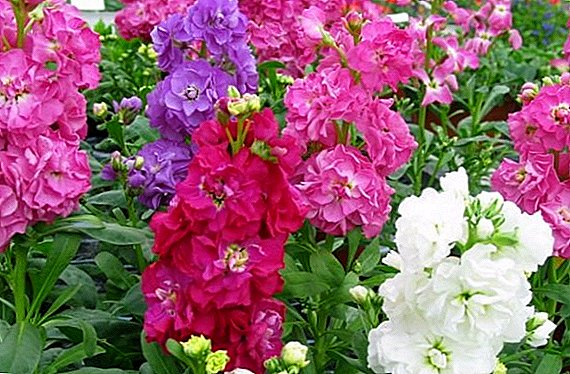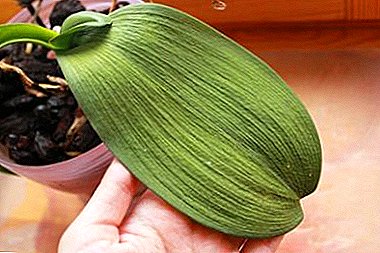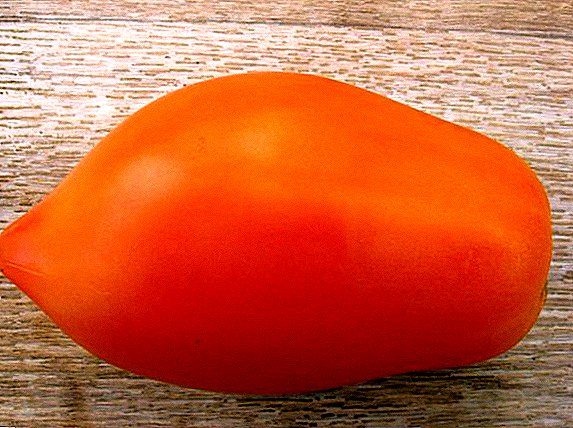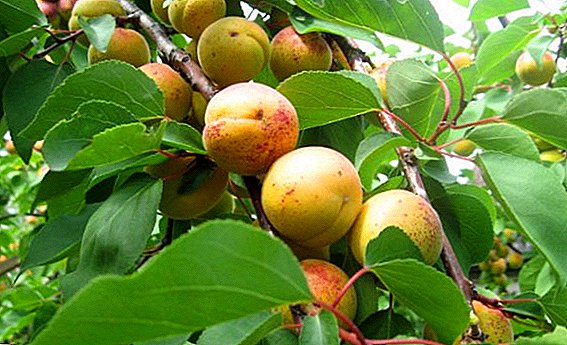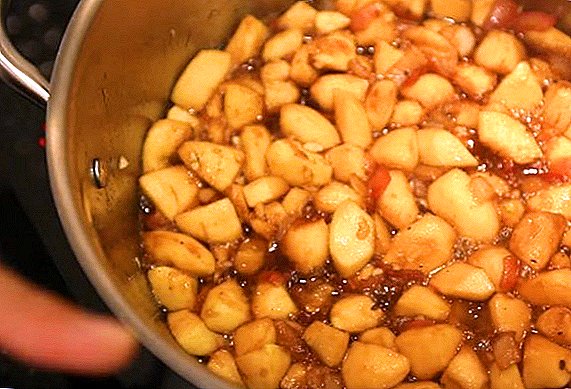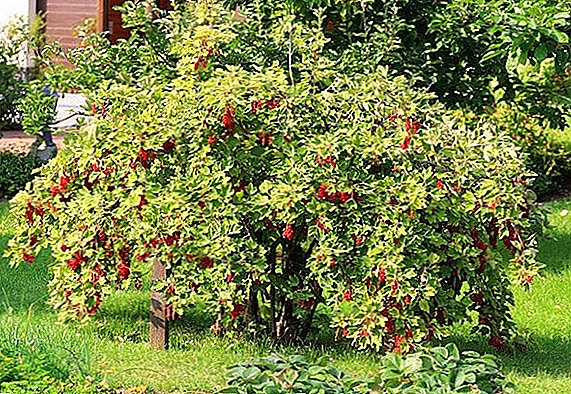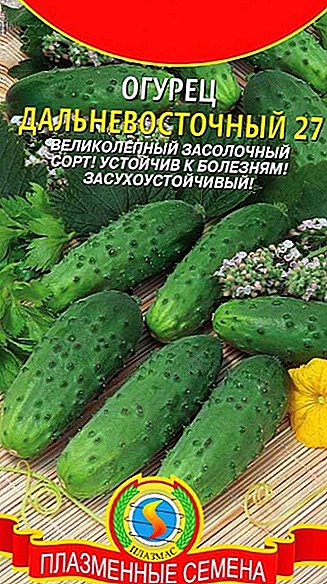 Cucumber variety "Far Eastern 27" has more than half a century, occupies a worthy place in the palette of domestic varieties. Gardeners of several generations have appreciated its quality. Let's take a closer look at how to sow and grow this variety, how to get a decent harvest.
Cucumber variety "Far Eastern 27" has more than half a century, occupies a worthy place in the palette of domestic varieties. Gardeners of several generations have appreciated its quality. Let's take a closer look at how to sow and grow this variety, how to get a decent harvest.
Variety description
"Far Eastern 27" - already quite old, mid-season variety. In 1950 obtained by the Siberian breeder Gamayunova E.A. in an experimental farm located in the Khabarovsk Territory. According to the state register of the Soviet Union, it is recommended for cultivation in the Far East and in the regions of the Far North (Primorye, Magadan, Kamchatka, the Amur Region and Yakutia).
Did you know? Cucumbers grow rapidly, but any stresses during growth (lack of water, poor soil, sudden cooling) can make their fruits bitter.
Grade advantages:
- cheap seeds;
- great taste;
- unpretentiousness to growing conditions.
We recommend to get acquainted with the best varieties of gherkin cucumbers, as well as beam, Dutch, Chinese, self-pollinated cucumbers.

Grade Disadvantages:
- a large number of male flowers (barren flower);
- propensity to overgrow the fruit.
Fruit characteristics and yield
- The grade begins to fructify for 40-55 day after emergence of the first shoots (mid-season).
- A plant with long lashes, well branched, bee pollinating variety.
- "Far East 27" - low-leaf plant, which simplifies the collection of cucumbers.
- Fruits are 11-15 cm long, with small tubercles, elongated.
- The peel is green with longitudinal white stripes and black spikes present.
- There is a wax on the skin.
- The flesh of the cucumber is crispy, juicy and tasty.
- The yield of the variety is one to three kilograms per square meter.
- Fruit weight - 100-200 grams.
- The variety is drought-resistant and cold-resistant.
- It has a relatively powdery mildew resistance.

Popular mid-season cucumber varieties include: "Ecole F1", "Claudia", "Libelle".
Selection of seedlings
What is a good cucumber seedlings:
- Bush should be stocky.
- The distance between the leaves is 7-10 cm.
- The leaves are large, bright green, without damage.
- The plant should be no more than 4-5 full leaves.
- Cucumber roots should occupy a capacity of at least 0.5 l.
- The age of the cucumber seedlings is not older than 30 days.
Did you know? Cucumbers contain most of the vitamins that a person needs every day: vitamin B1, vitamin B2, vitamin B3, vitamin B5, vitamin B6, folic acid, vitamin C, calcium, iron, magnesium, phosphorus, potassium, and zinc.

Soil and fertilizer
Cucumbers need warm, fertile soil with a pH from 6.0 to 6.8, although they can grow on slightly more alkaline soil (from pH to 7.6). In order to improve the soil and help create a good environment for the roots, which is necessary for a big harvest, it is necessary to bring rotten compost into the radical layer of soil and dig up the bed with the turnover of the reservoir.
It will be useful for you to read about what types of soil exist, how to improve soil fertility, how to independently determine the acidity of the soil at the site, as well as how to deoxidize the soil.
Also for cucumbers, you can prepare a bed in advance and fertilize it with manure:
- To do this, on the site of the future planting of cucumbers remove the top layer of soil (20-30 cm).
- In the resulting trench lay last year's plant garbage from the garden (leaves, small sticks). This layer will serve as a drainage for cucumber roots.
- The second layer (on top of vegetable garbage) is cattle manure. Lay a layer thickness of 10-20 cm.
- The third layer is laid ground previously taken from the trench.
- Cucumbers are very fond of such "sandwich" beds and they bear excellent fruit.

What they love:
- Cucumbers love warm, moist, loose, well-fertilized soil and sunlight (well-lit places).
- The beds should be well drained.
- Adding compost to the soil will help to quickly grow cucumbers, and the use of organic fertilizers, such as manure, will give the plants nutrients during growth.
- Cucumbers can be planted in high or ordinary beds.
- Since cucumbers are a weaving plant, they take up a lot of space when growing vstil.
- The most convenient way to grow cucumbers on the trellis. They just care, easy to harvest, cucumbers do not come into contact with the ground and do not get dirty.
Important! It is undesirable to plant cucumbers after the predecessor-cucumber or pumpkin crops. Spores of diseases and wintering pests can remain in the soil after a related culture.

Growing conditions
- Being a tropical vegetable, cucumbers feel great when the weather is hot (+20 - 28 ° C), and watering is abundant (at least 5 liters under each bush 2 times a week). You can water them in the basal trench (basal irrigation) or arrange drip irrigation in the garden bed. It is preferable, since with this method the soil will always be wet, but the bottom soil will not be eroded. It is unacceptable to water cucumbers by sprinkling - this can cause an outbreak of disease. Sick cucumbers will be very difficult to cure.
- As soon as the air temperature drops to +10 ° C - delicate cucumbers freeze in growth. If this weather lingers for two or three weeks, the cucumbers will fall ill and die.
- The soil must also be warm, then the root system branches well and goes deep into the soil. That is why a native of the tropics so fond of beds, "sandwiches." The decomposition process takes place in the soil filled with organic matter, which increases the soil temperature by a few degrees. The soil on a cucumber bed cannot be mulched until it warms up well, as the mulch will not allow the sun's rays to penetrate to the soil.
 Usually this time comes in early July.
Usually this time comes in early July. - These plants absolutely do not accept shading and cold, northern winds. Therefore, the bed for them is better to arrange on the south side near the wall of the house or near the fence, which will protect the landing from the wind.
Did you know? The emperor Tiberius demanded that cucumbers be served to his table all year round, regardless of whether it was summer outside or winter. It was this requirement that formed the basis for the emergence and realization of the idea of winter gardens and greenhouses.
Growing from seed to seedlings at home
Growing cucumber seedlings allows you to get an early harvest, as a tropical plant can not be sown in the ground until the first decade of May. And only in 35-37 days you can get the first green products. Growing seedlings in the house allows time: cucumber seedlings are planted at the age of 25-30 days, and the first cucumbers can be obtained in 1-2 weeks. 
You will probably be interested to read about whether and how to soak the seeds of cucumbers before planting.
Seed preparation
Cucumber seeds can be sown both dry and undergone preliminary presowing treatment:
- Seeds are soaked in warm water for swelling and germination.
- To do this, a flat plate is covered with paper napkins, abundantly moistened with water and the seeds are laid on top of it.
- A plateau with soaked seeds is wrapped in plastic wrap and placed in a warm place for a day.
- A day later, the seeds are ready for sowing.
Instead of water for soaking, you can use growth stimulants ("Epin", "Emistim") or biostimulants (aloe juice, melt water, honey).
Important! When soaking seeds, water or liquid growth stimulants should not cover seeds above 1-2 millimeters. If the water layer is thicker, it can cause the seeds to "suffocate" without oxygen. Plants also need oxygen for breathing.Video: preparing cucumber seeds for planting
Content and location
For each cucumber seed you need to select an individual planting cup. Since cucumbers have a taproot root system - the landing capacity must be deep. The most acceptable and cheap option is a half-liter plastic disposable cups.
This volume will be enough for one cucumber for 25-30 days of cultivation. If the planting of cucumber in the ground is delayed - the plant will begin to lag behind in growth, as a half-liter volume for the root system will not be enough.
It will be useful for you to learn how to grow properly to plant cucumbers for seedlings and when is the best time to plant cucumbers for seedlings.
Planting tanks should have holes in the bottom to drain excess water after watering. If the holes are not made, the root system will rot and the cucumber will gradually die. Holes in a plastic glass can be made with a nail heated on fire (2-3 holes will be enough).
Nutrient soil in planting glasses is not poured to the top, there should be at least 2 cm to the edge of the glass. This will make irrigation of seedlings more convenient and leave the gardener the opportunity to pour an extended seedling with soil.  Glasses with cucumbers growing in them should stand on the southern windowsill. Such a place will be lit during the day by sunlight, which is very important for a native of the tropics.
Glasses with cucumbers growing in them should stand on the southern windowsill. Such a place will be lit during the day by sunlight, which is very important for a native of the tropics.
Seed planting process
- Planting cups filled with soil a day before sowing (simultaneously with soaking the seeds) are watered moderately.
- After a day in the soil they make a depression 2-3 cm deep, where 2 seeds are planted at a distance of 2 centimeters from each other. In the future, one (the strongest) seedling will be selected, and the second will be removed. When removing an extra seedling, it is carefully cut near the ground, in no case pulling out, as this can damage the root system of a young cucumber growing next to it.
- Sown seeds are covered with soil and compacted.
- Since the soil was watered in advance, after sowing it is not watered.
- Cups with seeded seeds are placed in plastic bags and tied, then put in a warm place before germination.
- As soon as the first shoots seem - polyethylene immediately untie and rearrange the glass on the window. The plastic bag does not need to be completely removed from the planting cup, it will protect the window sill from water that has spilled from the planting tank.
Seedling care
- Glasses with cucumbers growing in them are placed on a well-lit window sill. On very sunny days, plants shade from the sun. For this, a large newspaper sheet is fixed between the glass and the cups with the seedlings. If this is not done, cucumber leaves can get sunburn.
- Three to four days after the emergence of shoots cucumbers begin to harden. To do this, twice a day, open the window for 30 minutes.
- In 2 weeks after the emergence of seedlings, the seedlings are brought out for quenching outside or on the balcony. For the first time, street hardening lasts 30 minutes, with each day the time spent in the fresh air increases by half an hour. A week later, cucumbers are on the street all day and are brought into the room only for the night.
- When hardening on the street, a slightly shaded place is chosen for placing the cups, they cannot be exposed to direct sunlight.
- Tempered seedlings are ready for transplanting (transfer) to a permanent place of residence.

Transplanting seedlings to ground
Seedlings ready for planting are planted when the soil warms up well and the constant air temperature does not fall below +15 ° C.
You can start a transplant:
- On a bed previously dug up and filled with organic fertilizers, holes are made into which the seedlings will be planted.
- The distance between the holes should be at least 15-20 cm, the depth and width of the hole should be slightly larger than the depth and width of the planting cup.
- The wells spill well, at least 3 liters of water fall into each hole.
- After the water in the planting holes has been absorbed, the gardener lays out cups of seedlings near the holes.
The cucumber is transplanted by the method of transshipment, as it is a very capricious plant, and if you accidentally damage the central root or tear several side roots, it will long stand in growth. 
Did you know? Cucumbers have a very low calorie - 16 kcal per 100 grams.
Instructions for transplanting cucumber:
- A gardener grabs the sapling with his fingers at the very base and turns the glass with the ground upside down.
- With the other hand, carefully remove the plastic cup from the earthen clod, after which the cucumber is carefully and carefully placed into the center of the hole along with the undisturbed earthen clod.
- Holding the earthen room with one hand, the gardener with the other hand sleeps the remaining space in the hole with soil.
- Experienced gardeners when filling the planting hole must make a small basal recess. In the future, this will facilitate watering.
- Planted in the ground saplings once again watered with lukewarm water. This watering is needed so that the earth has settled on the roots.
- Transplanted plants are shaded from the sun using agrofibre (spunbond) or tree branches stuck into the ground next to each seedling.
- Since in May there is no special heat, it is necessary to water cucumbers every two days.
- With the onset of heat, the soil under the cucumbers is mulched, and watered more often.
Agrotechnics growing seeds in open ground
Cucumbers are easy to grow by sowing right on the garden bed. To get healthy and strong plants, you need to adhere to the rules of cultivation of this culture.
Outdoor conditions
Crop of cucumbers can be obtained:
- in open ground;
- in the greenhouse;
- choose a combined option and temporarily arrange a polyethylene shelter over a garden bed.
Cucumbers do not like shading (even partial), therefore places for planting should be illuminated by sunlight throughout the day. The soil in the garden should be loose and fertile. If the soil has not been fertilized for a long time, it is necessary to "fill" the earth with organic matter.  For this fit puffed cattle manure, bird droppings, compost. If there is no organic fertilizer at hand, you can add nitrogen fertilizer or saltpeter to the garden bed before digging. Mineral fertilizers buy in specialized gardening shops, and choose fertilizers suitable for pumpkin crops.
For this fit puffed cattle manure, bird droppings, compost. If there is no organic fertilizer at hand, you can add nitrogen fertilizer or saltpeter to the garden bed before digging. Mineral fertilizers buy in specialized gardening shops, and choose fertilizers suitable for pumpkin crops.
When sowing cucumbers in the greenhouse or under temporary film shelters - the seeds will sprout faster and the plants will develop earlier than those sown in open ground. From greenhouses, the crop will start to flow to the table 2-3 weeks earlier than from the open ground.
The process of planting seeds in the ground
Pumpkin plants are planted in an open ground a week or two after the last spring freeze, by which time the soil has warmed up. 
How to sow:
- In the bed, a longitudinal groove is made (2-3 cm deep, arbitrary length).
- The groove is completely filled with water (to the top).
- Water should be given time to soak.
- When water is absorbed into the soil, it is time to plant.
- Cucumber seeds are laid out at the bottom of the planting furrow with an interval of 15-20 cm.
- Sown seeds covered with soil, previously taken out of the planting furrow.
- The sown bed is slightly compacted (tamped) and slightly watered.
- If sowing took place on the street, a temporary film cover can be constructed above the garden bed using several wire or plastic arcs and plastic film. The film thrown onto the arcs is strengthened by sprinkling the edges with soil or laying heavy bricks on the edge.
Watering
Just appeared gentle shoots of a cucumber need constant watering. A gardener must control the soil moisture and prevent it from drying out. In the first two weeks of life, seedlings need daily moderate watering.
Did you know? Cucumber is one of the earliest domesticated vegetables. People began to grow it about four thousand years ago, it was used not only in cooking, but also in medicine.
After 3-4 true leaves appear on young plants, the ground under the cucumbers should be mulched. For mulch used: straw, peat powder, humus, black and white or black agrofibre (spanbond). Mulch plants need less watering, as the mulch prevents the evaporation of moisture from the soil.
Learn how to water cucumbers in the open field and greenhouse.
 In the future, all summer cucumbers are watered two or three times a week, but very abundantly (to the dirt under the mulch). Watering is carried out in the evening, after the heat of the day subsides. If it was a rainy summer, then you need to water only when the soil on the garden is dry.
In the future, all summer cucumbers are watered two or three times a week, but very abundantly (to the dirt under the mulch). Watering is carried out in the evening, after the heat of the day subsides. If it was a rainy summer, then you need to water only when the soil on the garden is dry.
Important! Water for watering cucumbers take only defended and heated by the sun. In no case can cucumbers be watered with cold water from the water supply system. This will lead to decay of the roots. It is also impossible to water cucumbers on the leaf, it provokes the development of fungal diseases (powdery mildew).
Soil loosening and weeding
The soil under the cucumbers should always be loose and breathable. For this, once a week, the bed is loosened carefully, so as not to damage the root system of the plants. Weeding contributes to the fact that the cucumber beds remain clean from weeds.
Weeds on a cucumber bed are unacceptable, as they are peddlers of aphids and other harmful insects. If the zealous owners still covered the soil with organic mulch or agrofibre - this bed does not need weeding and loosening.  Soil under the mulch is always loose and wet, and the mulch prevents the appearance of weeds in the garden bed.
Soil under the mulch is always loose and wet, and the mulch prevents the appearance of weeds in the garden bed.
Masking
Some gardeners argue that it is possible to grow cucumbers without stading and shaping. Indeed, only in this case the gardener loses half of the crop, since a lot of barren flowers and few fruits form on an overly thickened plant. All nutrients are spent on building additional lateral shoots, and the plant does not have the strength to grow the main crop.
Check out the best tips for cucumber pickling.
Formation of cucumber:
- Three or four lower stepsons on the main stalk of cucumber are removed completely, cutting them off at the base.
- On all stepsons, which are located above, two internodes are left, where cucumbers will develop.
- Such shaping is applied to the very top of the plant and allows you to collect the greatest possible harvest.
Garter
Cucumbers do not like to touch the soil - this contributes to the development of fungal diseases. Therefore, the most suitable way for this culture is growing on trellis and supports. There is an erroneous opinion that being planted near the support, the cucumber will start climbing on it.
This is not entirely true - cucumber lash should be regularly sent and tied up:
- You can tie up the plants with a special gardening stapler or simply tying to the trellis with pieces of soft twine.
- In greenhouse cultivation, the plant's garter on an individual twine, fixed vertically, is common. In the process of growing plants gardener just wraps around a cucumber rope attachment.

Did you know? At present, China is the world's largest producer of cucumbers, producing more than three-quarters of the total volume of cucumbers on the planet. The total weight of China's varieties grown per year is about 55 million tons.
Top dressing
Cucumber needs regular feeding, as it quickly grows and increases its leaf mass.
There must be at least three feedings:
- the first dressing (urea 1 tablespoon, superphosphate 60 grams per 10 liters of water) - in the phase of two or three true leaves;
- the second (potash 20 grams and ammonium nitrate 30 grams, wood ash - 1 cup per 10 liters of water) - one month after the start of flowering;
- the third (liquid organic top dressing) is the period of active fruiting.
 Top dressing can be produced as foliar (by spraying on a leaf) or under the root.
Top dressing can be produced as foliar (by spraying on a leaf) or under the root.Preparing liquid organic fertilizer, this procedure is carried out on the street (outdoor):
- Take half a bucket of mullein or bird droppings, after which the bucket is filled to the top with water.
- The contents of the bucket are well mixed with a wooden stick and covered with a lid or plastic bag.
- A container with a liquid mullein is exposed to a well-lit place for fermentation for 7-10 days.
- The result is a fairly thick concentrated fertilizer.
- To get a working nutrient solution for feeding cucumbers, make an aqueous solution (10 liters of water + half a liter jar of concentrate).
- Immediately after dilution with water, the fertilizer is poured at the root of the plant. The solution can not stand for a long time, as this evaporates nitrogen.
- For the convenience of root dressings, a shallow groove is made on the bed right at the roots of the plants.
Pests, diseases and prevention
Mealy dew. Manifested in the form of a white plaque on the leaves and stems. The plant stops growing, stops fruiting, or bears fruit with gnarled, ugly fruits. Soon the leaves dry up and the cucumber dies. This disease affects both greenhouse cucumbers and those grown in the open field.
To combat the powdery mildew on cucumbers, fungicides such as Topaz, Fundazol, Tiovit, Skor, Kvadris, Topsin are used.
Weather contributing to the development of powdery mildew - sharp fluctuations in temperature from heat to cold and from drought to rainfall. As a prophylaxis, treatment with fungicides ("Topsin-M" or "Byleton") is used. At the first signs of the disease, fungicides are also sprayed on the beds.  Downy mildew Appears in the first decade of August, is capable of completely destroying cucumber plantations in a week. Manifested in the form of oily green spots on the leaves. Gradually, the spots crawl all over the sheet, later on in this place the sheet dries to brown.
Downy mildew Appears in the first decade of August, is capable of completely destroying cucumber plantations in a week. Manifested in the form of oily green spots on the leaves. Gradually, the spots crawl all over the sheet, later on in this place the sheet dries to brown.
After a couple of days, the leaf dries out completely and folds. It is a fungal disease, spores of the fungus overwinter in soil and plant debris. Spores begin to develop when watering cucumbers with cold water under the root or on the leaf.
We recommend reading about how to deal with pests and diseases of cucumbers.
If the gardener noticed the first signs of downy mildew, you need to temporarily stop watering and top dressing (for 7-10 days). Treatment with copper oxychloride solution is also required. As a therapeutic biological product, you can use whey and sprinkle it on the leaf. 
The disease will develop rapidly if the air temperature is below + 20 ° C- + 25 ° C. Cucumbers growing on the street (in the open field) - it is desirable to throw agrofibre or spunbond for insulation. In the fall, the soil on an infected bed should be poured abundantly with a solution of copper sulphate, as well as burned plant residues (lash and leaves).
Root rot. The disease develops with heavy watering and cold weather. It is possible to determine the disease by the fact that brown spots appear on the stem closer to the roots, merging into one with the development of the disease. Infected root rot cucumber dies.
In order to prevent further infection of the whole bed, the diseased plant is dug along with its roots, taken out of the garden and burned. Remaining after digging the hole is poured over blue vitriol. Preventive measures - do not water cucumbers if the air temperature drops below +15 ° C.  Cucumber mosaic. This is an infectious disease, the source of infection is diseased seeds or weeds growing next to a mosaic. On the leaf plates appear small green spots of different shades. The sheet becomes compressed, corrugated.
Cucumber mosaic. This is an infectious disease, the source of infection is diseased seeds or weeds growing next to a mosaic. On the leaf plates appear small green spots of different shades. The sheet becomes compressed, corrugated.
It is useless to treat a diseased cucumber mosaic, it is removed from the garden and burned. The tools with which the diseased plant was dug should be disinfected in bleach solution.
Did you know? To avoid a hangover headache in the morning after a fun party, you need to eat a few slices of cucumber before bedtime. Cucumbers contain enough sugar, B vitamins and electrolytes to replenish the lost nutrients that the body loses in the fight against alcohol intoxication.

Aphid. Populates the underside of the leaf plate. It settles in large colonies, the size of one individual 1.5-2 mm, the color of the body can be dark green or black. The pest is leaf-sucking, its presence inhibits the plant, causes twisting of the leaves and abscission of cucumber ovaries.
Mass settling of cucumber with aphids leads to his death. The natural enemies of aphids are ladybugs. These bright beetles are attracted by phytoncides, which emit umbrellas of dill or mustard seed, therefore fennel is sown near the bed of cucumbers.
To expel aphids, cucumbers should be sprayed with tobacco extract (a handful of tobacco per 5 liters of hot water, with a daily infusion) or garlic extract (50 grams of minced garlic per 10 liters of warm water, leave for a day).  Spider mite The smallest leaf-lining insect spreads very quickly to greenhouses. Its presence can be seen by the yellowing of the leaves and the thinnest web on the stems. The settling of cucumbers with spider mites leads to their death.
Spider mite The smallest leaf-lining insect spreads very quickly to greenhouses. Its presence can be seen by the yellowing of the leaves and the thinnest web on the stems. The settling of cucumbers with spider mites leads to their death.
Insecticide treatment helps against this pest. They can be bought at gardening stores. Also spider mite can leave plants treated with plant infusions (on yarrow, celandine, flowers and dandelion stalks, horse sorrel).
Spider mites overwinter in the ground, therefore, as a preventive measure, winter digging of the infected area is carried out, which further leads to the subsequent freezing of the pest.  Gall nematode. Microscopic worms (1-1,5 mm), populating the root system of a plant and gradually penetrating into its tissue. In the process of vital activity, the gallic nematode releases toxic substances that inhibit plants.
Gall nematode. Microscopic worms (1-1,5 mm), populating the root system of a plant and gradually penetrating into its tissue. In the process of vital activity, the gallic nematode releases toxic substances that inhibit plants.
The presence of a pest can be determined by the fact that cucumbers suspend growth, their yield decreases. On the plants affected by the pest, ugly growths and swellings can be seen — gall nematodes develop under them.
In order to cure the soil infected by the pest - the soil on the street beds is dug up before winter for freezing, in the greenhouses the soil is spilled with boiling water. There is one more very effective and simple method of cleaning the soil from gall nematodes: the whole area is thickly healed or sown with marigolds.  The roots of marigolds in the process of vegetation emit phytoncides into the soil, which the nematode does not tolerate. The following year, after the landing of the marigolds, the soil will be completely free from nematodes.
The roots of marigolds in the process of vegetation emit phytoncides into the soil, which the nematode does not tolerate. The following year, after the landing of the marigolds, the soil will be completely free from nematodes.
Harvesting and storage
How to collect fruits:
- Cucumbers are a fast-growing plant, so fruit picking should be done daily, and even better twice a day (morning and evening).
- Young cucumbers have a very delicate skin, so when harvesting, they should be folded into a plastic bucket or basin with smooth walls so as not to damage it.
- Cucumbers should not be allowed to outgrow, as they lose their taste and simultaneously inhibit the plant. One unpicked overgrown cucumber can interrupt the fruiting of a whole adult whip.
Did you know? Cucumbers were grown in space. Scientists on board the International Space Station were growing cucumbers to try to figure out what more influences downward growth of the roots — gravity (gravitropism) or water (hydrotropism). It turns out that it is water.

Read more about keeping cucumbers fresh for the winter.
How to store:
- A pickled cucumber quickly decays in places where the skin is damaged, so damaged cucumbers cannot be stored; it is advisable to eat them first.
- If the hostess is going to pickle or preserve the collected fruits, then until that time they can be stored in a cool place (basement, cellar or on the bottom shelf of the refrigerator), but not more than three days. After this period, the cucumber loses its turgor, becomes sluggish and soft.
- When it is supposed to store cucumbers for some time, they should never be washed, as this will cause the fruits to rot.
- Cucumbers plucked for food can be stored in the refrigerator for a week, but remember that their taste will deteriorate every day. Cut cucumber can also be stored in the refrigerator for several days. To do this, it is wrapped in plastic wrap (to prevent drying).

Possible problems and recommendations
Pustad on cucumbers. If cucumber whips are covered with flowers, but there are no fruits, something probably interferes with pollination. First you need to make sure that the plant has both male and female flowers. Male flowers usually appear at the beginning of the growing season, and later they become smaller.
Find out whether it is necessary to deal with empty flowers on cucumbers.
Within a week or two there will be female flowers, on the stem of each of them there is a thickening in the form of a tiny cucumber. In the future, this thickening will become an adult cucumber. If female flowers do not develop, and when they bloom, they dry out, then you will have to carry out pollination manually. It is not difficult.  Hand pollination:
Hand pollination:
- Early in the morning, (at 7-8 o'clock), the gardener goes to the garden, picks off the male flower and, without touching the pistil, neatly cuts off the petals on it.
- Holds a pistil of a male flower in the middle of female flowers. When the pollen from a male flower falls on the stamen of a female flower - pollination occurs, and as a result, the fruits become tied.
- In a week, cucumbers will hang on a trellis in clusters.
Yellow leaves. If the lower leaves (1-2) turn yellow - this is a normal process, as the lower leaves grow old, the sunlight does not reach them well - and as a result they fall. If yellow leaves appeared all over the plant, this is a signal that the plant lacks nutrients.
It is necessary to feed it with special mineral fertilizers for pumpkin plants or liquid organic fertilizer, the recipe of which is given above. With a little effort and effort, even an inexperienced gardener will be able to grow a great harvest of Far East 27 cucumbers with the help of the above tips and recommendations.


 Usually this time comes in early July.
Usually this time comes in early July.